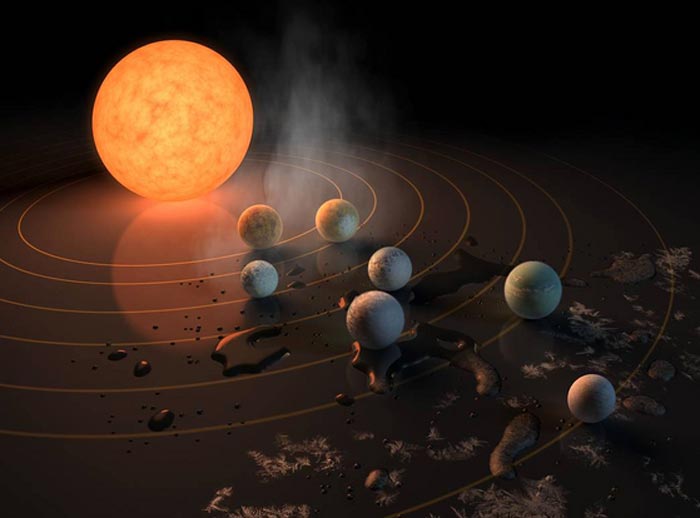Laughing gas in space could mean life

The TRAPPIST-1 system, where we may soon have more information about the atmospheres of rocky, Earth-like planets from the James Webb Space Telescope. It is possible the atmosphere could contain nitrous oxide, which might indicate life.
Credit: NASA/JPL-Caltech
Exoplanet hunters should check for N2O.
Scientists at UC Riverside are suggesting something is missing from the typical roster of chemicals that astrobiologists use to search for life on planets around other stars — laughing gas.
Chemical compounds in a planet’s atmosphere that could indicate life, called biosignatures, typically include gases found in abundance in Earth’s atmosphere today.
“There’s been a lot of thought put into oxygen and methane as biosignatures. Fewer researchers have seriously considered nitrous oxide, but we think that may be a mistake,” said Eddie Schwieterman, an astrobiologist in UCR’s Department of Earth and Planetary Sciences.
This conclusion, and the modeling work that led to it, are detailed in an article published today in the Astrophysical Journal.
To reach it, Schwieterman led a team of researchers that determined how much nitrous oxide living things on a planet similar to Earth could possibly produce. They then made models simulating that planet around different kinds of stars and determined amounts of N2O that could be detected by an observatory like the James Webb Space Telescope.
“In a star system like TRAPPIST-1, the nearest and best system to observe the atmospheres of rocky planets, you could potentially detect nitrous oxide at levels comparable to CO2 or methane,” Schwieterman said.
There are multiple ways that living things can create nitrous oxide, or N2O. Microorganisms are constantly transforming other nitrogen compounds into N2O, a metabolic process that can yield useful cellular energy.
“Life generates nitrogen waste products that are converted by some microorganisms into nitrates. In a fish tank, these nitrates build up, which is why you have to change the water,” Schwieterman said
“However, under the right conditions in the ocean, certain bacteria can convert those nitrates into N2O,” Schwieterman said. “The gas then leaks into the atmosphere.”
Under certain circumstances, N2O could be detected in an atmosphere and still not indicate life. Schwieterman’s team accounted for this in their modeling. A small amount of nitrous oxide is created by lightning, for example. But alongside N2O, lightning also creates nitrogen dioxide, which would offer astrobiologists a clue that non-living weather or geological processes created the gas.
Others who have considered N2O as a biosignature gas often conclude it would be difficult to detect from so far away. Schwieterman explained that this conclusion is based on N2O concentrations in Earth’s atmosphere today. Because there isn’t a lot of it on this planet, which is teeming with life, some believe it would also be hard to detect elsewhere.
“This conclusion doesn’t account for periods in Earth’s history where ocean conditions would have allowed for much greater biological release of N2O. Conditions in those periods might mirror where an exoplanet is today,” Schwieterman said.
Schwieterman added that common stars like K and M dwarfs produce a light spectrum that is less effective at breaking up the N2O molecule than our sun is. These two effects combined could greatly increase the predicted amount of this biosignature gas on an inhabited world.
The research team included UCR astrobiologists Daria Pidhorodetska, Andy Ridgwell, and Timothy Lyons, as well as scientists from Purdue University, the Georgia Institute of Technology, American University, and the NASA Goddard Space Flight Center.
The research team believes now is the time for astrobiologists to consider alternative biosignature gases like N2O because the James Webb telescope may soon be sending information about the atmospheres of rocky, Earth-like planets in the TRAPPIST-1 system.
“We wanted to put this idea forward to show it’s not out of the question we’d find this biosignature gas, if we look for it,” Schwieterman said.
Journal: The Astrophysical Journal
DOI: 10.3847/1538-4357/ac8cfb
Method of Research: Computational simulation/modeling
Article Title: Evaluating the Plausible Range of N2O Biosignatures on Exo-Earths: An Integrated Biogeochemical, Photochemical, and Spectral Modeling Approach
Article Publication Date: 4-Oct-2022
Media Contact
Jules Bernstein
University of California – Riverside
Jules.Bernstein@ucr.edu
Office: United States
All latest news from the category: Physics and Astronomy
This area deals with the fundamental laws and building blocks of nature and how they interact, the properties and the behavior of matter, and research into space and time and their structures.
innovations-report provides in-depth reports and articles on subjects such as astrophysics, laser technologies, nuclear, quantum, particle and solid-state physics, nanotechnologies, planetary research and findings (Mars, Venus) and developments related to the Hubble Telescope.
Newest articles

Tackling Life-Threatening Fungal Infections Using RNA Modifications
Importance of RNA modifications for the development of resistance in fungi raises hope for more effective treatment of fungal infections. An often-overlooked mechanism of gene regulation may be involved in…

Unraveling Aphasia: Global Study Breaks Down Patients’ Struggle with Verb Tenses
An international team of researchers, including scientists from the HSE Centre for Language and Brain, has identified the causes of impairments in expressing grammatical tense in people with aphasia. They discovered…

Facing the Storm: A Prepped Up Future Against Extreme Climatic and Weather Changes
From the persistent droughts of southern Africa and Central America in the early part of the year to the more recent devastating extreme rainfall in Spain and the deadly Hurricane…



